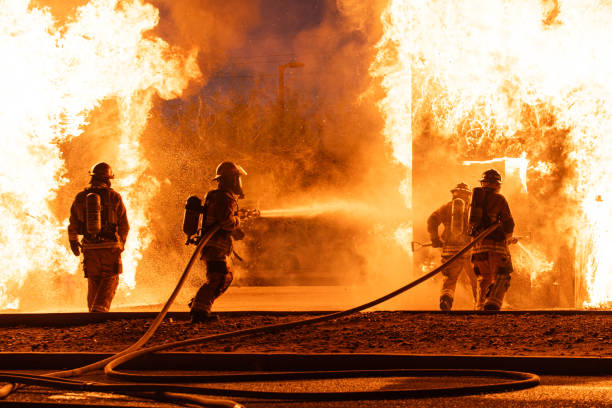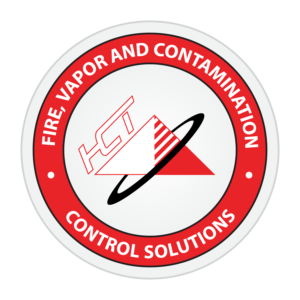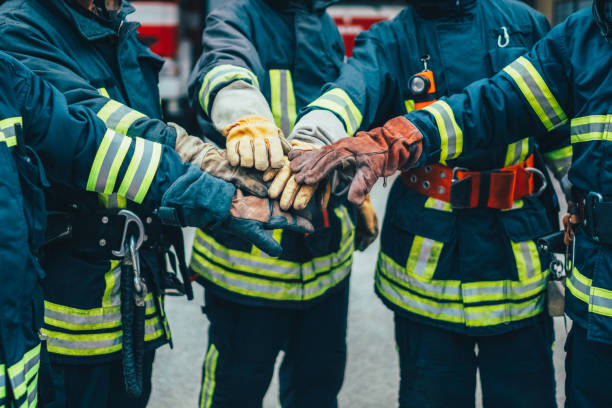Firefighting is a high-risk occupation that requires courage and dedication. Firefighters extinguish flames and save lives, but this job also exposes you to dangers that extend beyond the immediate threats of fire. One significant risk is cancer incidence among firefighters, attributed to being exposed to carcinogens through inhalation, dermal absorption, and ingestion.
This occupational exposure is linked to the toxic substances released during fires, including polycyclic aromatic hydrocarbons (PAHs), polyfluoroalkyl substances (PFAS), and diesel exhaust. The connection between these toxic substances and having an increased risk of cancer highlights a serious health issue within the firefighting community. It’s important to understand these risks and know how to protect yourself from these hazards.
The Risks of Being a Firefighter
You are probably well aware of the immediate dangers of this job, such as direct contact with fire and the risk of physical injuries. However, a less visible but equally important threat is your exposure to carcinogenic substances during fire suppression. This exposure happens through inhalation and contact with toxic chemicals, creating a long-term health risk.
PAHs, PFAS, and Diesel Exhaust
- Polycyclic Aromatic Hydrocarbons: Released during the combustion of various materials, including coal, gas, oil, wood, and even household items. PAHs can be absorbed through the skin or inhaled when you encounter smoke and soot at fire scenes.
- Polyfluoroalkyl Substances (PFAS): Used in firefighter protective clothing and equipment to resist water and stains. The National Institute of Occupational Safety and Health (NIOSH) has developed evidence around the presence of PFAS in equipment that’s used directly by firefighters and how it introduces another risk factor for cancer.
- Diesel Exhaust: Fire service teams are frequently exposed to diesel exhaust from fire trucks and other diesel-powered equipment. Classified as carcinogenic, this chemical contributes to your elevated cancer risk.
The combination of these substances emphasizes the need to have effective protective measures and safety protocols at each fire department. Addressing these risks is vital to safeguarding everyone’s health and well-being.

The Statistics
Research and statistical analysis reveal a concerning trend: firefighters face a 9% higher risk of cancer diagnosis and a 14% higher mortality rate from cancer than the general population. This elevated risk is attributed to the occupational hazards we mentioned (PAHs, PFAS, and diesel exhaust).
Increased Risks of Specific Cancers
NIOSH researchers have identified that firefighters are at a greater risk for certain types of cancer. Some of these include:
- Testicular Cancer
- Brain Cancer
- Leukemia
- Multiple Myeloma
- Malignant Melanoma
- Colon Cancer
- Liver Cancer
- Skin Cancer
- Prostate Cancer
- Non-Hodgkin Lymphoma
For example, firefighters are twice as likely to develop testicular cancer and have a higher incidence rate of bladder and prostate cancers compared to individuals not in this profession. If you’re a volunteer firefighter, there isn’t sufficient evidence on cancer statistics. However, the firefighting occupation in general increases cancer risk for everyone.
The Importance of Early Detection
Regular health screenings and monitoring for signs of cancer are essential aspects of improving your survival rates. Your fire departments should establish prompt health surveillance programs and training to protect everyone’s health and safety.

Protective Measures and Guidelines
High-quality personal protective equipment (PPE) is your first line of defense against carcinogenic exposure. Advances in protective clothing design, including materials that can effectively block or reduce the absorption of toxic substances, are crucial. Hazard Control’s F-500 Encapsulator Technology contributes to this method of protection by capturing the harmful toxins present in the area and on clothing. Firefighting turnout gear, gloves, boots, and helmets must also be evaluated and updated to ensure they offer you the best possible protection against immediate and long-term hazards.
Respiratory Protection
The self-contained breathing apparatus (SCBA) is extremely valuable for protecting your lungs from the inhalation of smoke and cancer-causing agents. Comprehensive training on the correct usage, regular maintenance, and timely replacement of SCBAs should be essential components of your safety protocol. Ensuring that these devices are used consistently can help reduce your risk of exposure.
National Firefighter Registry and Safety Guidelines
The National Firefighter Registry plays an important role in understanding the cancer risks associated with firefighting. They collect and analyze health and exposure data from firefighters across the United States. This information helps them develop specific occupational safety guidelines. Fire departments should participate in this registry and use the insights gained to create their cancer risk reduction strategies.
Decontamination and Firefighter Gear Maintenance
Effective decontamination processes for you and your equipment are vital in minimizing carcinogenic exposure. We encourage you to implement standard operating procedures for cleaning gear and vehicles after incidents. These protocols reduce the residues of carcinogens that linger on your equipment and in firehouses. Promoting regular health screenings and education on cancer risk factors and prevention are also important steps in early detection.
Cancer Prevention Training
Beyond the physical measures, there are resources to educate you and your team on best practices for cancer prevention. This includes training on proper gear usage and hygiene practices to minimize chemical exposure. The Lavender Ribbon Report is a resource that provides information on how fire departments are implementing these best practices. This information should empower you to take the initiative in protecting yourself and your peers.

Hazard Control Technologies’ Expertise in Lowering Firefighter Cancer Risk
Many fire departments struggle to find funding to combat these risks adequately. This is where Hazard Control Technologies comes into play. We are dedicated to improving firefighter safety through innovative fire suppression systems that reduce exposure to carcinogens and toxins. We combine advanced technology with practical solutions to enhance fire suppression and focus on the well-being of all first responders.
Perform NFPA 1851 Compliant Decon Practices with F-500 EA
Many fire departments already take part in helpful reactive practices, including performing NFPA 1851-compliant on-scene decontamination on turnouts and exposed skin.
The complete decontamination process post-incident often includes:
- Washdown
- Brushes
- Decon Bags
- Decon Wipes
- Laundering
- Showering
Following a fire call, wash down with a 1% solution of F-500 EA® to reduce the concentration of toxic residue on your exposed skin and turnout gear, promote a clean cab, and minimize the toxins you take home to your family.
Start Fighting Firefighter Cancer Proactively with F-500 EA
Prevent, lead, and encourage culture change.
What if your department could begin scrubbing the IDLH environment of a structure fire upon entry?
Smoke inhalation during a fire is a leading cause of death among firefighters and trapped civilians. Open your nozzle as you enter a structure, flowing a 1% solution of F-500 EA®, to improve visibility, lower unsafe temperatures, and reduce your exposure to carcinogens.
F-500 Encapsulator Agent can reduce the concentration of carcinogenic toxins encountered by firefighters at the nozzle, on the fire ground, and in the fire station.
Scientific Studies Illustrate F-500 EA’s Ability to Reduce Toxin Exposure
A comprehensive study was conducted by Laval Fire Department in participation with Ottawa University to reduce carcinogen toxin exposure related to firefighting in loving memory of firefighter Langis Villeneuve, who passed away of cancer-related to the profession in 2020 at 54 years old.
“Its use from day one could have minimized the amount of water used, production of smoke and number of hours worked by firefighters, but above all its use could have prevented the inhalation of carcinogenic fumes.” – Laval Fire Department
We empower you to incorporate our range of fire suppression agents and safety services as part of your strategy to mitigate occupational cancer risks. Partnering with HCT is a proactive step toward protecting your team against the long-term health effects of your work. Contact us today and learn how we prioritize firefighter safety and ensure safer working conditions for the future.
Resources:
- CDC – National Institute for Occupational Safety and Health. https://www.cdc.gov/niosh/index.htm
- Firefighter Cancer Support Network. https://firefightercancersupport.org/
- Hazard Control Technologies. https://hct-world.com/
- National Institute of Standards and Technology. https://www.nist.gov/




